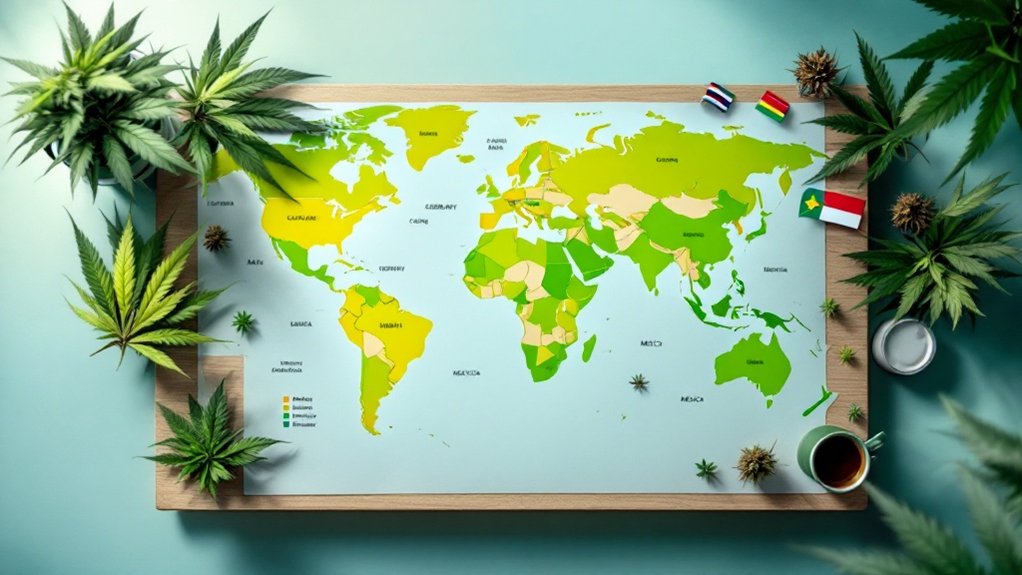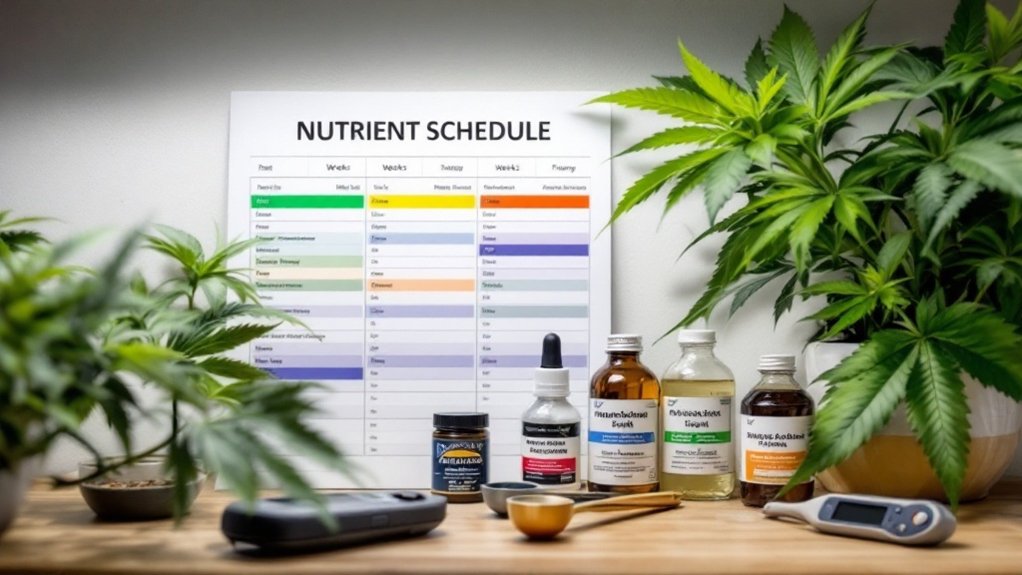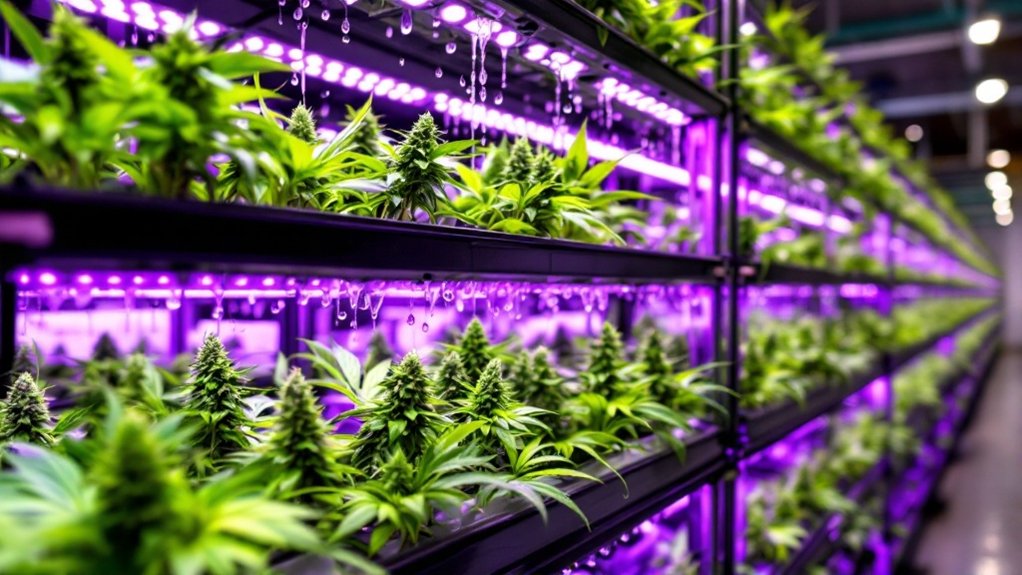Several countries have emerged as pioneers in marijuana legalization. Uruguay made history in 2013 as the first nation to fully legalize recreational cannabis, followed by Canada in 2018 with its extensive regulatory framework. Germany recently joined this movement in 2024, becoming the first major European economy to permit recreational use. Other notable models include Malta, Luxembourg, and Thailand, which have implemented various approaches ranging from state-controlled markets to personal cultivation allowances. These diverse regulatory frameworks offer valuable insights into balancing public health concerns with economic opportunities.

As the global landscape of cannabis regulation continues to evolve rapidly, an increasing number of countries have moved toward full legalization of recreational marijuana use since 2013.
Uruguay pioneered this shift as the world’s first nation to fully legalize recreational cannabis that year, implementing a state-controlled market where citizens can purchase through pharmacies or registered clubs. This model prioritizes public health and reducing illicit trade over commercial expansion, establishing a framework that other nations would later adapt to their own cultural and political contexts.
Canada followed in 2018 with nationwide legalization, creating a regulated commercial market that balances federal oversight with provincial control of retail regulations and advertising restrictions. Adults in Canada can possess up to 30 grams of dried cannabis for personal use. This thorough approach generated over CAD $4 billion in government tax revenue by 2023, demonstrating the potential economic benefits of legalization.
Germany joined these pioneers in 2024, becoming the first major European Union economy to permit recreational cannabis use, allowing adults to possess up to 25 grams and cultivate up to three plants for personal consumption through a system of licensed cannabis clubs.
The European continent has seen further policy reforms with both Malta and Luxembourg legalizing recreational cannabis use and limited home cultivation.
Malta permits adults to possess up to 7 grams in public and grow up to four plants per household, while both countries maintain small-scale, non-commercial regulatory models that prioritize personal use rights over market development. These approaches contrast with the Netherlands’ decades-old policy of tolerated sales in “coffeeshops” without full legal recognition.
Regional trends show accelerating legalization and decriminalization across the Americas, Western Europe, and parts of Africa.
Mexico’s Supreme Court decision in 2021 permits possession of up to 28 grams and cultivation of up to six plants per adult. South Africa’s Constitutional Court has ruled in favor of private cannabis use and cultivation while continuing to prohibit commercial sales.
Meanwhile, Thailand has emerged as an exception to Asia’s typically strict cannabis laws, allowing adults over 20 to possess and grow cannabis while projecting a legal market worth $9.6 billion by 2030. Many Asian countries maintain severe penalties for cannabis possession and trafficking, with some imposing death sentences for large quantities.
As Czech Republic and Ukraine consider cannabis reforms in 2025, the global movement toward marijuana legalization continues to gain momentum.
These diverse regulatory approaches offer valuable insights into balancing public health concerns with personal freedoms and economic opportunities.
Frequently Asked Questions
How Do Legal Marijuana Markets Impact Local Economies and Job Creation?
Legal marijuana markets stimulate local economies by generating direct jobs in cultivation, retail, and distribution while creating indirect employment in ancillary sectors.
The industry creates diverse positions ranging from agricultural workers to compliance specialists, with projections indicating over 500,000 cannabis-related jobs in the U.S. by 2025.
Additionally, tax revenue from regulated sales funds public services, while cannabis businesses revitalize communities by occupying vacant spaces and increasing foot traffic to neighboring establishments.
What Health Risks Remain Even in Countries With Legal Marijuana?
Even in countries with legal marijuana, significant health risks persist.
Cannabis use disorder remains prevalent, affecting 9-30% of users, while frequent consumption of high-potency products increases psychosis risk.
Respiratory complications mirror those of tobacco smoking, including chronic bronchitis and decreased lung function.
Regular use during adolescence can impair brain development and cognitive functioning.
Additionally, cannabis-impaired driving contributes to increased motor vehicle accidents and related fatalities, representing a substantial public health concern across legalized jurisdictions.
How Do Countries Handle Marijuana-Impaired Driving Detection and Enforcement?
Countries employ various methods for detecting cannabis-impaired driving.
Some nations like Uruguay and several U.S. states implement zero-tolerance policies, where any detectable THC constitutes an offense.
Others establish per se limits that specify THC blood concentration thresholds.
Roadside testing includes oral fluid screening devices, such as the Securetec DrugWipe 5s used in Australia, and field sobriety tests.
Many jurisdictions combine biological testing with behavioral assessment conducted by specially trained officers or Drug Recognition Experts to determine actual impairment.
Can Tourists Purchase and Use Marijuana in Countries Where It’s Legal?
Tourists’ ability to purchase and use marijuana varies greatly between countries with legal frameworks.
Canada and some U.S. states permit tourists to buy cannabis from licensed retailers, while the Netherlands allows purchases in designated “coffeeshops.”
Conversely, Uruguay restricts sales to citizens and residents only.
Many jurisdictions enforce possession limits, with Canada permitting up to 30 grams and Portugal decriminalizing quantities up to 25 grams.
Public consumption remains illegal in most locations, regardless of purchase legality.
How Has Legalization Affected Youth Marijuana Consumption Rates?
Contrary to predictions from legalization opponents, youth marijuana consumption has markedly decreased during periods of state legalization.
National survey data shows lifetime marijuana use among adolescents dropped from 39.9% to 27.8% between 2011-2021, while past 30-day use fell from 23.1% to 15.8%.
Research published in JAMA found no evidence that state legalization laws increased youth cannabis use.
Additionally, studies report substantial reductions in the percentage of youths indicating easy access to marijuana following legalization.









